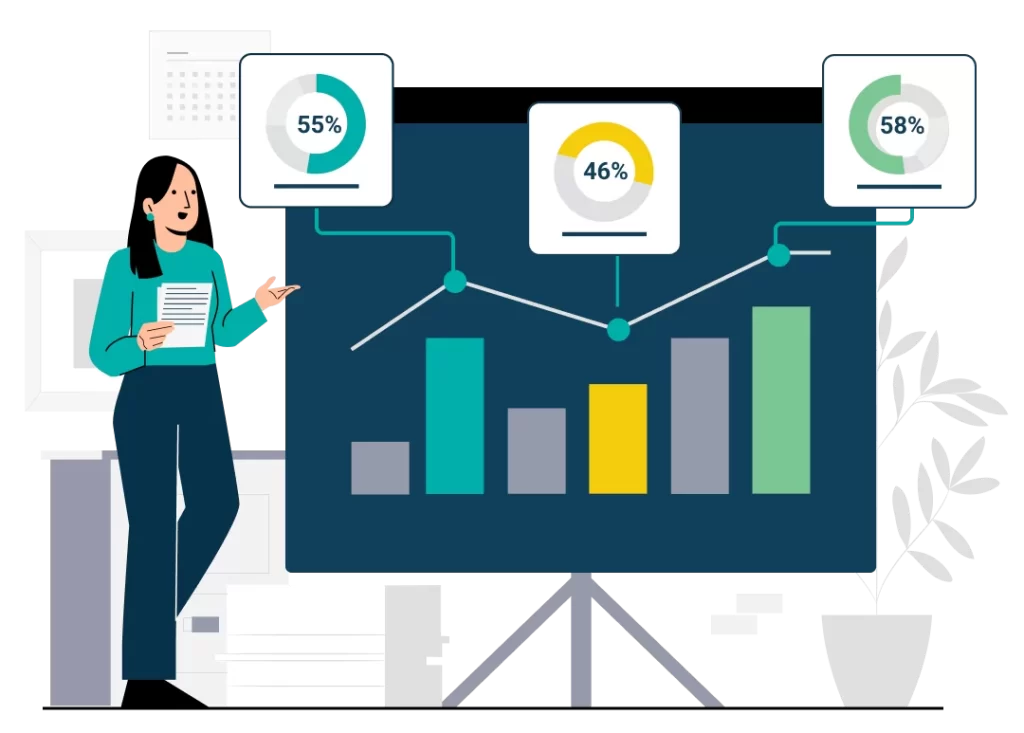You’re choosing between infinite scroll and pagination. It looks like a UX decision, but it creates backend costs that multiply 3-5x as you scale.
The database impact is where things get expensive. Offset pagination forces your database to read and then discard rows, degrading performance as users dig deeper. Meanwhile, cursor-based pagination maintains consistent performance regardless of dataset size.
This pattern is one of many infrastructure cost patterns where seemingly simple UX choices create exponential backend expense. You need quantitative cost analysis, not just UX theory. This article breaks down actual infrastructure costs—server processing, database operations, CDN bandwidth, and developer productivity. You’ll understand the total cost of ownership before committing to a pattern.
We’ll compare both frontend patterns (infinite scroll versus traditional pagination) and backend implementations (offset versus cursor pagination). The economics are counterintuitive—the “simpler” patterns often cost more at scale, similar to how architectural complexity creates unexpected expenses in distributed systems.
What Are the Actual Infrastructure Costs of Infinite Scroll Versus Pagination?
Infrastructure costs break down into server processing, database query execution, CDN bandwidth, and caching overhead. Each component scales differently depending on which pattern you choose.
Traditional pagination with a cursor backend optimises database query efficiency regardless of dataset size. The database performs an indexed seek to the cursor position and returns results. Same operation whether you’re at item 20 or item 100,000.
Infinite scroll paired with offset pagination creates exponentially increasing database costs as your dataset grows and users scroll deeper.
CDN bandwidth costs increase 40-60% with infinite scroll despite smaller individual payloads. More frequent requests mean more HTTP header overhead. Each request carries 500-800 bytes of headers regardless of payload size.
Total monthly infrastructure costs at 1 million active users: offset pagination runs $800-1,200, cursor pagination $300-500, infinite scroll with cursor $500-800. Database query efficiency matters more than API call frequency for overall economics.
How Does Offset Pagination Become Exponentially More Expensive at Scale?
Offset pagination uses the SQL OFFSET clause, which doesn’t simply skip rows—it reads them and then discards them. At page 1, the database scans zero rows. At page 100 with 20 items per page, it scans 1,980 rows just to skip them.
With 100 million entries, a few users trying to open the last page can create more load than hundreds of users browsing early pages. Database CPU costs scale with scanned rows, not returned rows. You pay for all the data it reads and discards.
Benchmarks tell the story. At page 5,000 in a 1 million row table, offset pagination took significantly longer than cursor pagination’s 0.13 seconds—17 times slower. Deeper pages consume more database resources, increasing per-query costs exponentially.
How Does Cursor Pagination Reduce Database Costs Compared to Offset Pagination?
Cursor pagination uses indexed column values—like ID or timestamp—as position markers instead of counting rows. The database performs an indexed seek directly to the cursor position without scanning previous rows. Query complexity remains constant regardless of dataset size or position in results.
Performance stays consistent. Retrieving items 1-20 takes the same time as items 100,000-100,020. Database CPU usage remains constant per query regardless of data volume. Benchmarks show cursor pagination maintained consistent response times across all pages while offset degraded exponentially.
The execution plan proves the efficiency. Instead of “Parallel Seq Scan” you see “Index Scan using idx_user_notes_date_id”. The database uses your index to seek directly to the position.
Cost reduction at scale: 70-85% lower database costs compared to offset pagination. This requires proper indexing on your cursor column, but that’s a one-time setup cost that pays dividends immediately. If it works today with 10,000 rows, it will work in 10 years when you have 10 million rows.
What Are the Hidden Server Costs of Implementing Infinite Scroll?
Infinite scroll requires 3-5 times more API calls per user session compared to traditional pagination. Each API call incurs server processing overhead—authentication, authorisation, request parsing, response serialisation.
More frequent small requests create higher computational overhead per byte transferred than fewer large requests. Your load balancer processes each request independently. Session state gets validated. Middleware runs. All this happens whether you’re returning 20 items or 100.
State management complexity increases server-side processing. You need to track user position and prevent duplicate content. If sites try to keep track of users’ location during pogo sticking, there could be a ton of content to be loaded whenever the user returns.
Load balancer costs scale with request count, not data volume. Delivering 1,000 items via infinite scroll might take 50 API calls versus 10 page loads for pagination. That increases server processing costs by roughly 40%.
How Do Caching Strategies Differ in Cost Between Infinite Scroll and Pagination?
Traditional pagination enables aggressive page-level caching. Page 1 results are identical for all users. Cache hit rates of 80-95% are common for popular pages.
Infinite scroll creates personalised result streams that are harder to cache. Different users scroll to different positions. Each cursor position represents a different query. Hit rates drop to 40-60%.
Database query caching works well for pagination’s predictable access patterns. Same queries repeat across users. But infinite scroll’s sequential cursors create unique queries for each scroll position. Cache invalidation is simpler for paginated content—you know exactly which pages are affected when data updates.
The cost impact: effective caching reduces database query costs by 60-80% for pagination versus 30-40% for infinite scroll. At scale, pagination caching can offset 50% of your total database costs.
What Is the Developer Time Cost to Implement Infinite Scroll Versus Pagination?
Traditional pagination implementation takes 8-12 hours for an experienced developer. Frontend UI plus backend API. The pattern is well-understood, libraries exist, edge cases are documented.
Infinite scroll requires 20-30 hours due to state management complexity, scroll event handling, and edge case testing. Cursor pagination is more complex to implement correctly, especially when handling ties and ensuring stable ordering.
Adding cursor pagination to your backend adds 4-6 hours over offset pagination. If multiple order-by clauses are used, keyset pagination queries become very complicated.
Testing infinite scroll edge cases takes 2-3 times longer. Loading states, scroll position restoration, duplicate prevention, race conditions—all need thorough testing.
Developer time at $100/hour: pagination costs $1,200-1,800 versus infinite scroll at $2,400-3,600. Debugging complexity adds 30-40% ongoing maintenance time for state-related issues.
Total first-year cost including implementation and maintenance: pagination runs $3,000-4,000 versus infinite scroll at $5,500-7,000. This developer time investment is one component of the broader UX decision framework for evaluating infrastructure cost trade-offs.
How Much Does CDN Bandwidth Cost Differ Between Infinite Scroll and Pagination?
Infinite scroll generates 3-5 times more HTTP requests but each carries a smaller payload—maybe 20 items instead of 100. HTTP header overhead matters more with frequent small requests. Headers consume 500-800 bytes per request regardless of payload.
Traditional pagination: 10 requests times 1KB headers equals 10KB overhead for delivering 1,000 items. Infinite scroll: 50 requests times 1KB headers equals 50KB overhead for the same 1,000 items.
CDN pricing typically charges per request plus per GB transferred. Request count matters significantly. Costs at 1 million users monthly: pagination CDN costs run $120-180 versus infinite scroll at $180-280. That’s a 50% increase.
Optimisation can reduce this gap. Infinite scroll with request batching—loading larger chunks per scroll event—can approach pagination costs. But batching adds complexity and can harm the smooth scrolling experience.
Slow speed tends to be a problem for mobile users due to variable connectivity or users in areas with low bandwidth or on limited data plans. More requests mean more round trips, more opportunities for network delays.
When Does the Infrastructure Cost of Infinite Scroll Exceed Pagination?
The crossover point depends on scale, usage patterns, and backend implementation. With offset pagination backend, infinite scroll costs more from day one. High API frequency plus degrading query performance is expensive immediately.
With cursor pagination backend, infinite scroll becomes more expensive around 100,000-500,000 monthly active users. Below that threshold, costs are manageable.
Key factors: average items viewed per session, scroll depth distribution, cache hit rates. If users typically view fewer than 50 items, infinite scroll costs are manageable. Above 100 items viewed, pagination becomes cheaper.
Database costs dominate at scale. Choose cursor pagination for performance-critical APIs, real-time feeds, or scenarios where users frequently access deep pages. News and social feeds with high scroll depth favour pagination economics. Product catalogues with low scroll depth can afford infinite scroll.
Rule of thumb: if infrastructure costs matter, use cursor pagination backend regardless of frontend pattern. This is where understanding performance optimisation trade-offs becomes critical—sometimes the “faster” UX creates higher costs that don’t justify the marginal improvement.
FAQ Section
Should I use infinite scroll or pagination if I’m worried about server costs?
Use traditional pagination with cursor pagination backend for lowest infrastructure costs. If infinite scroll is required for UX reasons, implement cursor pagination backend and monitor API call frequency closely—never use offset pagination with infinite scroll.
Why is my offset pagination getting slower and more expensive as we scale?
Offset pagination forces the database to scan and skip all previous rows before returning results. As your dataset grows and users access deeper pages, query time increases exponentially because the database must scan millions of rows just to discard them before reaching the offset position.
How do I calculate whether infinite scroll or pagination is cheaper for my use case?
Track three metrics: average items viewed per user session, your dataset size, and current database query costs. If users typically view more than 100 items, pagination will be cheaper. Calculate: (API calls per session times server cost per call) plus (database queries times query cost) for each pattern at your scale.
What metrics should I track to understand the real cost of my pagination approach?
Monitor database query execution time by page depth, API call frequency per user session, CDN bandwidth consumption, cache hit rates, and server CPU utilisation per request. Set alerts when query times exceed 200ms or cache hit rates drop below 60%.
What database optimisation costs are required for infinite scroll?
Cursor pagination requires proper indexing on the cursor column—usually ID or timestamp. That’s typically 2-4 hours developer time plus minimal storage overhead (2-5% of table size). This one-time cost reduces ongoing query costs by 70-85% compared to offset pagination.
How does cursor pagination work with infinite scroll on the frontend?
Infinite scroll frontend automatically fetches the next batch as the user scrolls. Backend API returns results plus a cursor value—the last ID or timestamp. The next request uses this cursor to locate where to continue fetching results. The database uses an index to seek directly to that position without scanning previous rows.
Can I migrate from offset to cursor pagination without breaking my existing UI?
Yes—this is purely a backend change. Your frontend pagination UI remains identical while the backend switches from OFFSET/LIMIT to cursor-based queries. Migration takes 4-6 hours for a typical application, immediately reducing database costs without any user-facing changes.
What are the debugging costs for infinite scroll issues?
Infinite scroll debugging takes 30-40% more time than pagination due to state management complexity. Common issues: duplicate items, scroll position loss, loading state bugs, race conditions. Budget extra developer time for edge case testing and monitoring scroll state consistency.
How much more does infinite scroll cost to run than regular pagination?
With cursor pagination backend: 30-60% higher infrastructure costs due to increased API calls and reduced cache effectiveness. With offset pagination backend: 200-400% higher costs due to exponential query degradation combined with request frequency overhead. Backend implementation matters more than frontend pattern.
What’s the cheapest way to implement pagination for a large dataset?
Cursor pagination backend with traditional pagination frontend offers the lowest total cost: consistent query performance, excellent cache hit rates, simple implementation, and easy debugging. Cost at 1 million users: $300-500/month infrastructure plus $1,200-1,800 initial development.
Does infinite scroll always mean worse performance and higher costs?
Not always. With proper cursor pagination backend, small datasets (under 100K rows), and users viewing few items (under 50 per session), infinite scroll costs remain manageable. The pattern becomes expensive with large datasets, deep scrolling, or poor backend implementation. Context matters.
How do I test which pagination pattern costs less for my specific application?
Implement both with cursor pagination backend in a development environment. Simulate realistic user behaviour with load testing tools measuring actual API calls, query times, and bandwidth. Calculate costs: (requests per user times users times server cost) plus (query time times queries times database cost). Metrics beat theoretical analysis.
Conclusion
Pagination pattern choices create measurable infrastructure cost differences that compound at scale. Cursor pagination with traditional pagination UI delivers the lowest total cost of ownership—predictable query performance, excellent cache effectiveness, and straightforward implementation. Infinite scroll with offset pagination creates the highest costs through exponential query degradation and reduced cache efficiency.
The economics are clearer when you measure actual costs rather than optimising for perceived performance. For more examples of how technical decisions create unexpected financial implications, explore our comprehensive guide to the hidden economics of technical decisions.












